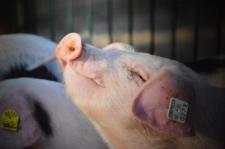But these startling scenarios are under consideration...
Aggregated News

Scientists trying to grow human organs inside pigs in an attempt to tackle a shortage of donors have successfully created part-human, part-pig embryos.
Researchers at the University of California, Davis combined human stem cells and pig DNA and allowed the embryos to mature for 28 days, before terminating the experiment and analysing the tissue.
They believe the animals, which if they had been carried to term would have developed a human internal organ, but would have looked and behaved like any other pig. The goal is that in the future, similar animals could potentially act as a ready source of organs for life-saving transplants.
To create the “chimeric” embryos, the scientists used a gene-editing technique known as Crispr to knock out a section of the pig’s DNA necessary for the embryo to develop a pancreas.
Human induced pluripotent (iPS) stem cells were then injected into the pig embryo. These are cells that have the potential to develop into any tissue type in the resulting foetus. Although genetically foreign, they are not rejected by the pig embryo because its immune system...



